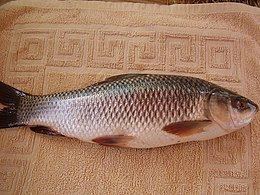Infraclass Teleostei Superfamily Cyprinioidea | Superclass Osteichthyes Superorder Ostariophysi Phylum Chordata Rank Subfamily Subclass Neopterygii | |
 | ||
Lower classifications Cirrhinus molitorella, Mrigal carp, Osteochilus vittatus | ||
Labeoninae tribe shark cyprinids
Labeoninae is a doubtfully distinct subfamily of ray-finned fishes in the family Cyprinidae of order Cypriniformes. They inhabit fresh water and the largest species richness is in the region around southern China, but there are also species elsewhere in Asia, and some members of Garra and Labeo are from Africa. They are a generally very apomorphic group, perhaps the most "advanced" of the Cyprinidae. A common name for these fishes is labeonins (when considered a distinct subfamily) or labeoins (when included in subfamily Cyprininae).
Contents
They include the group sometimes separated as Garrinae, but these do not seem to be that distinct. In fact, the entire Labeoninae is merged into the Cyprininae by a number of authors; in any case, these two and the former "Barbinae" form a close-knit group whose internal phylogeny is far from resolved. If the subfamily is considered distinct, it is typically split in the tribes Labeonini (which are able to swimm well in open water) and Garrini (which are mostly benthic), and sometimes in addition the Banganini (which are somewhat intermediate in habitus) If the labeo lineage is included in the Cyprininae, it becomes the tribe Labeonini, while its two (or three) subdivisions are the subtribes Labeoina, Garraina and perhaps Banganina.
Notable genera are Crossocheilus, Epalzeorhynchos and Garra, which contain some of the popular aquarium fishes often called "algae eaters", e.g. the Siamese Algae Eater (Crossocheilus siamensis). Labeo – the type genus of this subfamily – contains many sizeable species which are often used as food.
Anatomically, the labeonins are distinguished by the Weberian apparatus contacting the skull with the supraneural bones, and its basioccipital process being concave in cross-section. The first vertebra has a parapophysis that is elongated to forward and partially overlaps the basioccipital process. The fourth vertebra, meanwhile, has a short but stout transverse process that is prominently elongated bellywards; the os suspensorium is often hidden behind if viewed from the side. In the skull, the frontal and sphenotic bones have prominent foramina. In the anal fin, the first pterygiophore is elongated and has well-developed anterior and posterior flanges, with the former very large and concave at the distal end. Most labeonins have the skinny flap of the underside of the snout well-developed into a fleshy cap that at least partially hides the upper lip except when feeding, and a similar structure at the lower lip.
Genera
The supposed genus "Tylognathus", commonly placed in the Labeonini (or Labeoina), is actually a polyphyletic assemblage containing diverse labeonins and some other cyprinids. Its type species, variously called "Tylognathus diplostoma" or "Tylognathus valenciennesii", is actually Bangana diplostoma; most of its other species are now in Lobocheilos.
